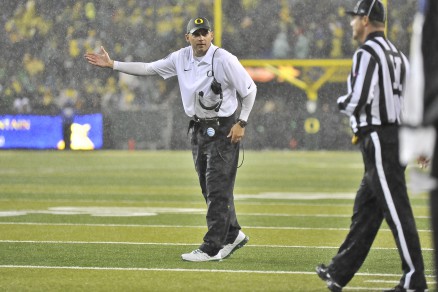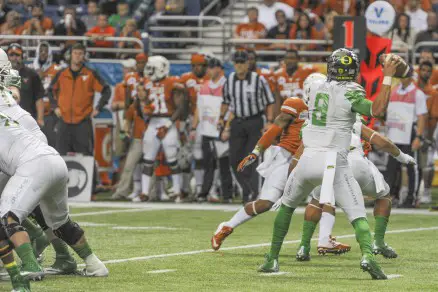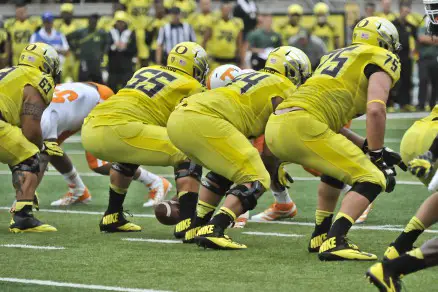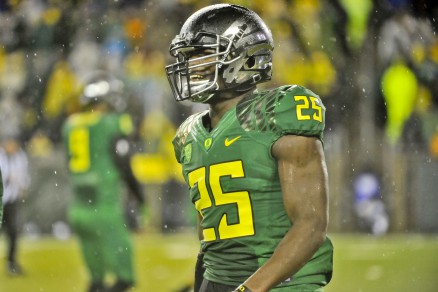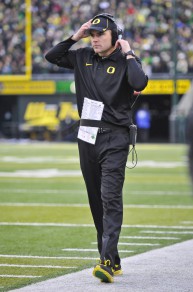National LOI signing day is a lot like Christmas for those of us who follow recruiting. A few of us have rich parents and expect the world, while others come from blue collar families. All of us wake up early and wait in agony for mom and dad to come downstairs so that we can start opening presents. Sometimes, we get exactly what we want. During lean years, we get socks instead of that bike we begged for. But then signing day IS exciting, if nothing else.
Yesterday was a big day for the Ducks. Come early morning, fans were eagerly awaiting the decisions of Trey Lealaimatafao, Mattrell McGraw, Khalil Oliver and John “JuJu” Smith. Defensive tackle Lealaimatafao got the day started by choosing to sign with LSU, which he referred to as “DTU.” Hard to argue with that.
Oregon fans breathed a sigh of relief when McGraw announced for Oregon, confirming the various reports that he’s long been a silent commit. Next was Oliver, who also committed to Oregon over the likes of Washington and Boise State. None of those three decisions were surprising. The big question of the day was where 5-star Smith would be playing his college football.
After many rumors and a lot of confidence on Oregon’s end going into the decision, Smith decided to stick with the hometown Trojans. It was a tough end to the 2014 cycle, but just where do the Ducks stand now?
On the Thursday after signing day, every fan-base around the country is optimistic about their class. Some are more excited than others, but almost everyone justifies their class by citing the “potential” and “upside” of each recruit. And while most of the attention is on a player’s ceiling, what separates the good classes from the great ones, at least initially, is the number of players with high floors.
A guy with a high-floor is someone who is expected to make a definite contribution to the team (usually, within the first two years). Not coincidentally, these are normally the players with the highest ratings. I’m particularly fond of players with high floors since, historically, they’re the most likely to pan out (I know, genius). Keep that in mind throughout this article as I grade Oregon’s class.
Grading by position group is a good way of summarizing the class. Note that I’m fairly “harsh” when it comes to grading. This isn’t your local state college, where a readable paper will get you an A-. No, this class is curved and the majority of students end up with C’s.
I’m basing these grades on what could have been reasonably expected of Oregon this recruiting cycle. For simplicity, I’m not going to use any +/- values with the letter grades:
Quarterback
Tier-1: Morgan Mahalak
Grade: B
Oregon needed a quarterback in this class and they got one of the first individuals they pursued. Mahalak is a unanimous 4-star who sat behind Cal QB Jared Goff as a junior, so he was a bit of a late bloomer. He was always extremely high on Oregon, though, and after his commitment, he became a recruiter for the Ducks, trying to get others to join him in Eugene. Mahalak has a lot of upside and it wouldn’t be a surprise if he takes the reins once Mariota leaves for the NFL. This isn’t an “A” because Mahalak isn’t seen as a lock to be a Pac-12 starter, but he’s still a really good pickup.
Running Back
Tier-E: Royce Freeman
Tier-1: Tony James
Grade: A
Not sure Oregon could’ve done any better here. Freeman is one of the premier backs in the country and gives Oregon size at the position that they haven’t had since Blount. Freeman’s size and running style remind some of Jonathan Stewart. While not quite as fast, he might have even better feet. Guy fans are already calling him “Rolls Royce” and could well be an all-timer for the Ducks.
Not to be outdone, Tony James is a big-time recruit as well. Despite dealing with some injury issues that will likely require a redshirt year, the small, shifty back is reminiscent of another out-of-state running back recruit named “James” who wore No. 21. If Tony can be half the player that LMJ was, Oregon hit a home run. Props to Gary Campbell for proving, once again, that he is an elite recruiter.
Wide Receiver
Tier-1: Jalen Brown
Tier-3: Charles Nelson
Grade: C
Losing Budda Baker wouldn’t have been a big deal had JuJu Smith spurned SC for Oregon, but alas, it was not to be. Either one of those guys would’ve changed this grade to an “A.” Honestly, a “C” may be the harshest grade handed out in this article, but the sting of losing Baker and then Smith (after hearing as of Tuesday night that he was a “slam dunk” to Oregon) is definitely an influence here.
I actually love both Brown and Nelson. Brown could start from day one as a smooth, natural route runner with great hands. Nelson is a Tier-1 talent who didn’t get the attention he deserved until late in the process following a bad knee injury sustained early in his junior season; offers from Notre Dame, USC, Florida and Miami support that conclusion. Think of Nelson as a less-sudden De’Anthony Thomas but who is more polished as a receiver.
*My justification for the “C” grade is that I believe it’s reasonable to expect Oregon to bring in two good receivers each cycle, especially when one is a unanimous 3-star (even if that rating isn’t indicative of Nelson’s talent-level).
Offensive Line
Tier-1: Haniteli Lousi
Tier-2: Tyrell Crosby
Tier-2: Braden Eggert
Grade: C
This group is a bit of a disappointment. Lousi provides some instant depth and Crosby and Eggert both have plenty of upside, but there’s no surefire stud in this group. When UCLA, Stanford and USC are sucking up every elite offensive lineman every single year, it’s reasonable to be concerned. This grade would’ve been a “B” had the Ducks landed one of the many other lineman they had a shot at (Sam Jones, Kolton Miller, Jaden Gault, Layth Friekh, Quinn Bailey, Chris Brown or Nick Gates). It is tough to watch Oregon continue missing on elite prep lineman.
Defensive Line
Tier-1: Tui Talia
Tier-3: Henry Mondeaux
Tier-3: Jalen Jelks
Tier-3: Austin Maloata
Grade: C
Like the offensive line, it’s hard not to be disappointed with this group. Tui Talia is a JUCO prospect and should make an immediate and significant contribution, but he’s the only guarantee in the class. Mondeaux, Jelks and Maloata are all fairly raw. All three will need to add weight and develop the prerequisite skill-set.
While there’s plenty of upside in this group, you’d love to see a couple of preps who already had the size and talent to compete at the D1 level in a 3-4 scheme. Depending on the development of a high-upside Tier-3 lineman sounds good in theory, but in reality, few teams who do it find success. And we see yet again that at a position Oregon struggles to recruit, USC, UCLA and Stanford are all hoarding the most highly-rated prospects.
*It’s worth noting that had Lealaimatafao committed to Oregon, I may have changed this grade to a “B,” but the above paragraph would still ring mostly true (Lealaimatafao has a much higher floor than any of Oregon’s other prep defensive line signings).
Linebacker
Tier-1: Jimmie Swain
Tier-3: Justin Hollins
Grade: B
While few are particularly excited about this group, it fills a need with players the staff coveted. The Ducks brought in four linebackers last cycle, so there wasn’t a huge need.
Swain is a talented, versatile linebacker who could end up outside at Sam or inside at Mike, depending on how he develops (both physically and with his game). Hollins, meanwhile, is a guy who didn’t get a ton of attention playing across from the number one player in the country, Myles Garrett. Nonetheless, Oregon was on him early in the process and apparently coveted his length and potential (as did Baylor, Missouri, Oklahoma and Oklahoma State). Look for him to end up at Sam or Drop-end.
Defensive Back
Tier-1: Arrion Springs
Tier-1: Mattrell McGraw
Tier-3: Glen Ihenacho
Tier-3: Khalil Oliver
Tier-3: Dominique Harrison
Grade: A
John Neal does it again. This is a yet another great haul for the legendary DB coach, and every player in this group listed Neal as the reason for their commitment. That goes to show the impact position coaches have on recruiting. Springs is an elite corner who was offered by almost everybody. He was a very vocal member of the class and became a recruiter for Oregon early in the process.
McGraw played on one of the best teams in the country and has serious potential. Ihenacho might be the most exciting prospect in the group. He certainly has the bloodlines to be successful as his older brother, Duke, is a starting safety for the Denver Broncos. Ihenacho’s film is also fantastic – I have no idea why he’s not a 4-star.
Rounding out the group, Khalil Oliver is an unsung guy out of Idaho who, due to his location, didn’t get much exposure. The jump in competition level will be significant, but he’s obviously a football player. He’s a fun player to watch. I won’t be surprised if he adds some weight and ends up at linebacker because he can “put guys to sleep.”
Finally, Dominique Harrison is a polished JUCO corner who should be able to come in and compete for playing time right away. Whether or not he makes an immediate contribution, he adds experienced depth that’ll be needed in 2015 after Ekpre-Olomu, Hill and Mathis have all graduated.
Overall Grade: B-/C+
I know that I said I wouldn’t use any +/- values, but I lied. I couldn’t justify a pure “B” or “C” grade here. Remember, I’m basing these evaluations off of what I consider to be reasonable expectations, and by no means did this class surpass those.
Ultimately, the lack of elite prep talent along the offensive and defensive lines is the reason this class grade isn’t higher. The class features a number of players who figure to make significant contributions early on such as Royce Freeman, Jalen Brown, Haniteli Lousi, Tui Talia and Arrion Springs along with a bunch of guys who have seemingly high upsides (which, again, almost every fan in America is saying about the majority of their non-blue-chip recruits).
As with any class, this group’s true value won’t be known for a few years. As it stands now, it’s hard to complain. It’s also hard to get overly excited about a group that doesn’t surpass pre-cycle expectations.
Next week, I’ll take a look at what this class means for the 2015 cycle, but until then, take comfort in the fact that Oregon got better yesterday. They added more talent (per the recruiting rankings) than they lost to graduation. That’s a step in the right direction.
Landing a 5th straight top-25 class (No. 21, from all reports) is something Oregon and the program’s fans should be proud of. Considering the inherent geographic difficulties at the heart of Oregon’s recruiting strategy, the 5/25 stat is impressive. More than that, it keeps Oregon competitive, the entire purpose of recruiting. For that, the staff should be commended and the fan-base, hopeful.
For some, this class excites them about the direction of the program. To you I say, don’t lose your faith. For others, concerns abound, but don’t get down; there is still plenty of room for optimism. After all, this is the first day of the 2015 cycle. I’m sure it’ll be Oregon’s best class ever.
Top photo by D.C. Photography
Related Articles:
Chip Kelly Update: Everything's Good Again ...
Chip Kelly Update: Wailing and Gnashing of Teeth
Shock and Awe -- The Oregon Ducks' Football Hangover Effect
Despite Lopsided Score, Georgia State "Never Stopped Believing"
Hope Springs Eternal for Ducks
Incompetent Pac-12 Officials: How Do You Miss ALL of THIS?
Chris was born in Montevideo, Uruguay, but made his way to Oregon by the age of five, when he attended his first game at Autzen Stadium. A huge sports fan at a young age, Chris grew up playing football, basketball and golf. Although realizing he isn’t likely to play in the NFL or NBA, Chris still holds on to hopes of being a professional golfer should his unfortunate putting woes take a turn for the better. A bit of a platypus, he attended both Oregon State and Oregon during his collegiate days where he earned a business degree in Finance and Business Administration. Chris works for Daimler Trucks North America in Portland, and plans to get his MBA from the University of Oregon.
Chris has been an active member in the recruiting community since 2005. He studies the intricacies of recruiting and is particularly intrigued by talent evaluation techniques. He is currently working on developing his own scouting reports for every scholarship player on the UO roster. Chris lives with his wife, Katrina, and his two-year-old son Lucas (a future dual-threat QB).


